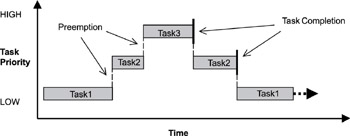Книга: Real-Time Concepts for Embedded Systems
4.4.5 Scheduling Algorithms
Разделы на этой странице:
4.4.5 Scheduling Algorithms
As mentioned earlier, the scheduler determines which task runs by following a scheduling algorithm (also known as scheduling policy). Most kernels today support two common scheduling algorithms:
· preemptive priority-based scheduling, and
· round-robin scheduling.
The RTOS manufacturer typically predefines these algorithms; however, in some cases, developers can create and define their own scheduling algorithms. Each algorithm is described next.
Preemptive Priority-Based Scheduling
Of the two scheduling algorithms introduced here, most real-time kernels use preemptive priority-based scheduling by default. As shown in Figure 4.4 with this type of scheduling, the task that gets to run at any point is the task with the highest priority among all other tasks ready to run in the system.

Figure 4.4: Preemptive priority-based scheduling.
Real-time kernels generally support 256 priority levels, in which 0 is the highest and 255 the lowest. Some kernels appoint the priorities in reverse order, where 255 is the highest and 0 the lowest. Regardless, the concepts are basically the same. With a preemptive priority-based scheduler, each task has a priority, and the highest-priority task runs first. If a task with a priority higher than the current task becomes ready to run, the kernel immediately saves the current task’s context in its TCB and switches to the higher-priority task. As shown in Figure 4.4 task 1 is preempted by higher-priority task 2, which is then preempted by task 3. When task 3 completes, task 2 resumes; likewise, when task 2 completes, task 1 resumes.
Although tasks are assigned a priority when they are created, a task’s priority can be changed dynamically using kernel-provided calls. The ability to change task priorities dynamically allows an embedded application the flexibility to adjust to external events as they occur, creating a true real-time, responsive system. Note, however, that misuse of this capability can lead to priority inversions, deadlock, and eventual system failure.
Round-Robin Scheduling
Round-robin scheduling provides each task an equal share of the CPU execution time. Pure round-robin scheduling cannot satisfy real-time system requirements because in real-time systems, tasks perform work of varying degrees of importance. Instead, preemptive, priority-based scheduling can be augmented with round-robin scheduling which uses time slicing to achieve equal allocation of the CPU for tasks of the same priority as shown in Figure 4.5.

Figure 4.5: Round-robin and preemptive scheduling.
With time slicing, each task executes for a defined interval, or time slice, in an ongoing cycle, which is the round robin. A run-time counter tracks the time slice for each task, incrementing on every clock tick. When one task’s time slice completes, the counter is cleared, and the task is placed at the end of the cycle. Newly added tasks of the same priority are placed at the end of the cycle, with their run-time counters initialized to 0.
If a task in a round-robin cycle is preempted by a higher-priority task, its run-time count is saved and then restored when the interrupted task is again eligible for execution. This idea is illustrated in Figure 4.5, in which task 1 is preempted by a higher-priority task 4 but resumes where it left off when task 4 completes.
- Scheduling Tasks
- 4.6.4. Real-Time Scheduling
- 9.2.3. Scheduling
- 10.2.2. Scheduling
- Algorithms
- Using Priority Scheduling and Control
- Creating and scheduling backups with Wbadmin
- 17.1.3. Linux Scheduling
- 3.3. ELECTION ALGORITHMS
- 4.4. SCHEDULING IN DISTRIBUTED SYSTEMS
- 3.1.3. Clock Synchronization Algorithms
- 3.2.4. A Comparison of the Three Algorithms




